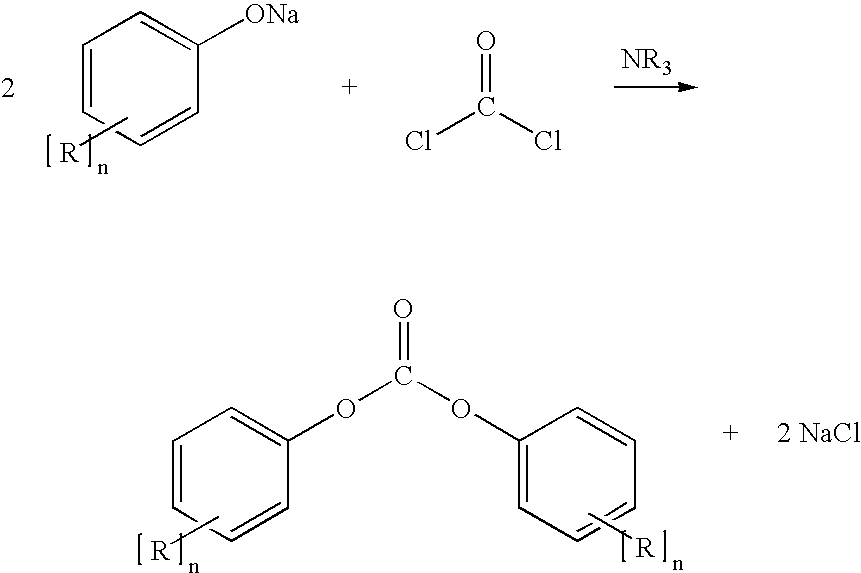Process for the production of diaryl carbonates and treatment of alkalichloride solutions resulting therefrom
a diaryl carbonate and alkali metal chloride technology, which is applied in the field of diaryl carbonate production and treatment of alkali metal chloride solutions resulting therefrom, can solve the problems of inability to carry out processes economically, high cost, and inconvenient purification operations
- Summary
- Abstract
- Description
- Claims
- Application Information
AI Technical Summary
Benefits of technology
Problems solved by technology
Method used
Image
Examples
example 1
Addition of Sodium Chloride-Containing Reaction Wastewater to Sodium Chloride Electrolysis
Addition of a 17 Wt. % Sodium Chloride Solution from DPC Production
[0079] A mixture of 145.2 kg / h of 14.5% sodium hydroxide solution and 48.3 kg / h of phenol are brought together with a solution of 86.2 kg / h of methylene chloride and 27.5 kg / h of phosgene (8 mole % excess based on phenol) in a vertically standing, cooled tubular reactor. This reaction mixture is cooled to a temperature of 33° C. and, after an average residence time of 15 seconds, a pH of 11.5 is measured. In the second step of the process, 5.4 kg / h of 50% NaOH are then metered into this reaction mixture so that the pH of the second reaction step is 8.5 after a further residence time of 5 minutes. In the continuously operated reaction, metering fluctuations that occur are offset by adjusting the additions of NaOH in each case. In the second step of the process, the reaction mixture is continuously mixed by passing through a pip...
example 2
Addition of Sodium Chloride-Containing Reaction Wastewater to Sodium Chloride Electrolysis with a Gas Diffusion Electrode
Addition of a 17 Wt. % Sodium Chloride Solution (Reaction Wastewater) from DPC Production
[0084] The wastewater corresponded to the quality of that according to Example 1. Since no hydrogen is required for the production of DPC, the formation of hydrogen during the electrolysis can be omitted. The electrolysis was therefore operated with gas diffusion electrodes. The current density was 4 kA / m2, cathode side outlet temperature 88° C. and anode side outlet temperature 89° C. An electrolytic cell with a standard anode coating from DENORA, Germany, was used. A Nafion 982 WX ion exchange membrane from DuPont was used. The electrolytic voltage was 2.11 V. The sodium chloride concentration of the solution removed from the anode compartment was 17 wt. % NaCl. 0.166 kg / h of 17 wt. % reaction wastewater and 0.0553 kg / h of solid sodium chloride were added to the NaCl solut...
example 3
Addition of Sodium Chloride-Containing Reaction Wastewater to Sodium Chloride Electrolysis with a Gas Diffusion Electrode
Addition of a 17 Wt. % Sodium Chloride Solution (Reaction Wastewater) from DPC Production
[0087] The wastewater corresponded to the quality of that according to Example 1. Since no hydrogen is required for the production of DPC, the formation of hydrogen during the electrolysis can be omitted. The electrolysis was therefore operated with gas diffusion electrodes. The current density was 4 kA / m2, cathode side outlet temperature 88° C. and anode side outlet temperature 89° C. An electrolytic cell with a standard anode coating from DENORA, Germany, was used. A Nafion 2030 ion exchange membrane from DuPont was used. The electrolytic voltage was 1.96 V. The sodium chloride concentration of the solution removed from the anode compartment was 15 wt. % NaCl. 0.178 kg / h of 17 wt. % reaction wastewater and 0.0553 kg / h of solid sodium chloride were added to the NaCl solutio...
PUM
| Property | Measurement | Unit |
|---|---|---|
| concentration | aaaaa | aaaaa |
| current density | aaaaa | aaaaa |
| temperature | aaaaa | aaaaa |
Abstract
Description
Claims
Application Information
 Login to View More
Login to View More - R&D
- Intellectual Property
- Life Sciences
- Materials
- Tech Scout
- Unparalleled Data Quality
- Higher Quality Content
- 60% Fewer Hallucinations
Browse by: Latest US Patents, China's latest patents, Technical Efficacy Thesaurus, Application Domain, Technology Topic, Popular Technical Reports.
© 2025 PatSnap. All rights reserved.Legal|Privacy policy|Modern Slavery Act Transparency Statement|Sitemap|About US| Contact US: help@patsnap.com



